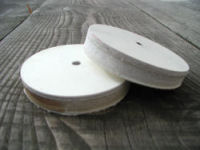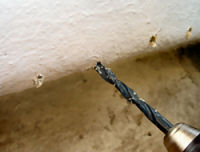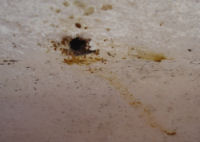Most of the Freeman boats decks and cabin structures are double skinned GRP with a foam infill. This varies in depth throughout the boat and even from boat to boat, generally about an inch (25mm) of foam.
The Problem
Often people notice a sponginess on the fore deck (around the bow), very often this is nothing more than the fact that people have regularly jumped off the bank onto the boat, therefore compressing the GRP and foam. The GRP then springs back up and can separate from the foam. This can easily be cured by the remedy discussed below.

The more worrying problem is if water has got into the foam through a deck fitting improperly sealed or, as is quite likely, the pulpit rail base seals. Sometimes this is hit, for example on a lock pile but it springs back to shape. Whilst you initially consider that there is no damage, it may have split the seal where the foot joins the deck.
The problem is potential water ingress into the foam. The foam then absorbs the water like a sponge, if the foam cannot dry out the water will build up and degrade the foam and eventually the GRP, too.
Please note that Mr. Freeman used a Mastic Tape as the sealant and we have never found anything better, the problem with modern silicone sealants, in this instance, is that when you tighten the deck fitting down it pushes most of the silicone out, this leaves a very thin membrane and is insufficient to cope with the movements / contractions of the boat. Mastic Tape is available by metre or roll from the Freeman Shop.
The Solution

Firstly you need to remove furniture fittings etc to gain access to the fore deck and drill some exploratory holes from inside upwards (being careful not to go so deep, so as to penetrate the outer skin). If the problem is in the roof, initially removing the cabin lights will allow you to gain some access to see the condition of the foam.
We now need to continue drilling a series of holes in the suspect areas and allow any water to drain and drip dry. This may take a number of weeks and therefore is a suitable job for the winter period. Obviously immediate attention has to be given to sealing the deck fittings or to the cause of the water ingress.

Once dry, an expanding foam aerosol can be used to replenish the damaged foam, these usually come with an 8mm plastic nozzle, therefore it is probably a good idea to use an 8/9mm drill when making the holes. The holes should be quite numerous in the damaged area, as not only will this allow the water to drain more quickly and evenly. But when you come to apply the foam it will allow for expansion as the foam dries, letting the excess out of the holes instead of expanding the top deck, leaving an undulating top surface.
Finally the holes can be cleaned and plugged with a GRP filler, sanded and finished in keeping with the surrounding area.
Note
Protective clothing should not be overlooked owing to working upside down with GRP and foam.
Parts for this job are readily available from the Freeman Shop.